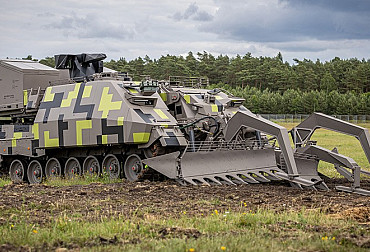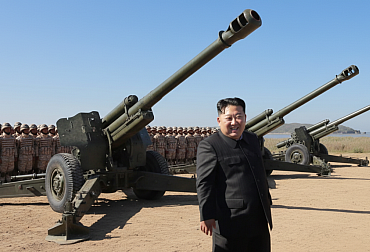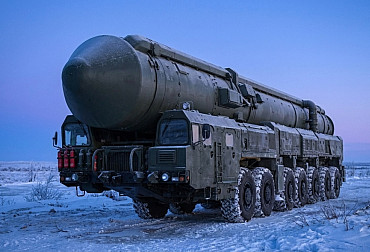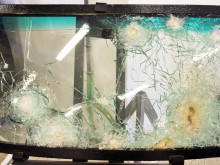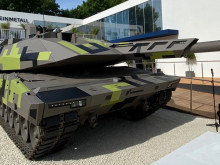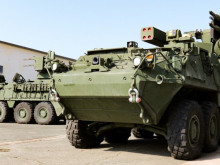Patriot – armoured vehicle (not only) for Central Europe
In July, a report appeared in the media about the Polish army's decision to introduce a large number (in the order of hundreds) of Ottokar Brzoza wheeled missile tank destroyers into the arsenal. In fact, this is also a huge success for the Czech arms industry, because the basis of these missile tank destroyers is a vehicle called Autosan Waran, which is a Polish derivative of the Czech armored vehicle Patriot II from Excalibur Army. It is probably worth mentioning that the meaning of the name actually corresponds to this, as the successful Polish WWI general Ottokar Brzoza-Brzezina was born in the Czech town of Protivín. Somewhat paradoxically, the Patriot platform is not yet in the Czech Army's arsenal, although this could change. It clearly shows that armoured vehicles of this category are very useful platforms with a wide range of possible applications, both in asymmetric conflicts and in conventional wars.
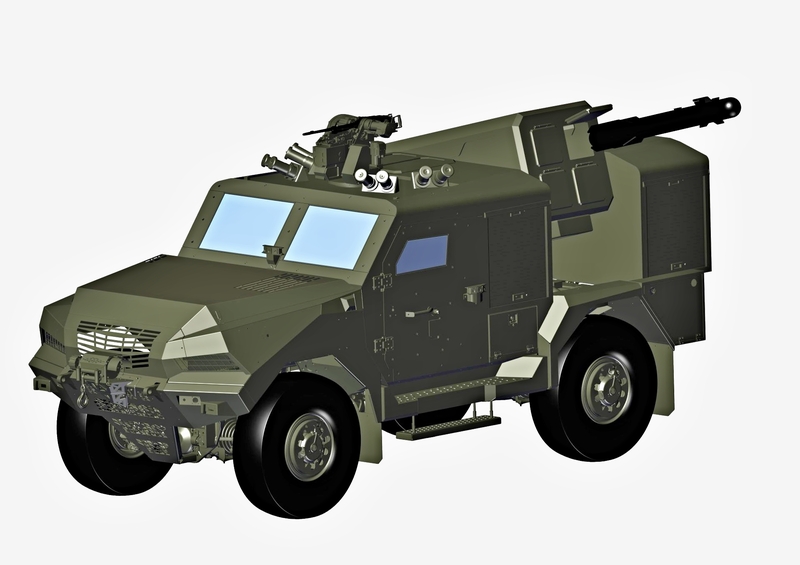 Picture: Ottokar Brzoza tank fighter | PGZ
Picture: Ottokar Brzoza tank fighter | PGZ
Patriot and Patriot II vehicles can be briefly characterised as armoured vehicles with a high level of resistance to ballistic and explosive threats. They are based on the four-wheel chassis of the Tatra Force series (Tatra T815-7), which in itself represents a guarantee of excellent off-road mobility, durability and flexibility. Of course, this is not the first time that a chassis from Kopřivnice has been used as the basis for an armoured vehicle of this category, as Tatra Trucks has provided its products to a number of companies, which then constructed their armoured vehicles on this basis. These include the Wildcat type from the Israeli armaments company IMI, the Al-Washsh armoured vehicle from the Jordanian brand KADDB, the Rila Xtreme vehicle from IAG in the United Arab Emirates, or the Legion type, which belongs to the portfolio of the Isotrex company, also based in the Emirates. The fundamental difference, however, lies in the fact that the Patriot design can boast a purely Czech origin, as it was developed and produced by Excalibur Army itself, which is part of the Czechoslovak Group.
.JPG)
The first form of the Patriot armoured vehicle was introduced in 2018, followed a year later by the Patriot II version, which is distinguished primarily by the use of a longer chassis. The first Patriot received a 3,500mm wheelbase chassis and offers space for the driver, passenger and four other people, while the Patriot II used a 3,650mm wheelbase chassis and offers more interior space. In addition, the '2' features a redesigned body face that enhances the vehicle's ballistic protection, as the unusually sloping areas on the Patriot II's face contribute greatly to increasing the effective armour thickness. In its basic form, the Patriot II offers NATO STANAG 4569 level 2 ballistic protection, but if desired, the ballistic resistance of the body can be increased to level 4, so that the Patriot II can withstand penetrating rounds from large-calibre machine guns.
.jpg) Picture: Patriot II armoured vehicle | Excalibur Army
Picture: Patriot II armoured vehicle | Excalibur Army
Mine resistance can be equivalent to NATO STANAG 4569 levels 2a/2b or 3a/3b, which means that the chassis can withstand the explosion of an anti-tank mine with a 6 kg or 8 kg TNT equivalent charge, respectively, under either wheel or under the centre of the chassis. The combat weight of the Patriot II armoured personnel carrier is between 13.5 and 17.5 tonnes, depending on the chosen level of protection and specific equipment, while the lighter "one" weighs about 12 tonnes. Ensuring the high mobility of such an armoured vehicle obviously requires a powerful engine. The customer can thus choose between air-cooled Tatra T3C-928 series diesels (power from 230 to 325 kW) and water-cooled units from Cummins (power 210 or 270 kW). In both cases, these engines can also meet the Euro 3 standard, so the Patriot II can also operate in normal road traffic. The vehicle can reach a speed of 110 km/h, can wade to a depth of 1.2 m without preparation and can overcome a 0.9 m wide ditch or a 0.5 m high vertical obstacle.
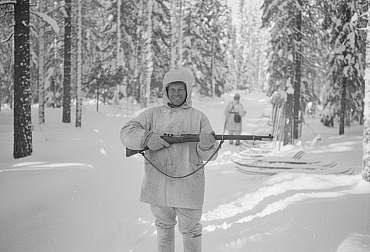
The primary use of the Patriot series vehicles is for deployment with rapid reaction forces, for which they can serve primarily as reconnaissance, patrol and force transport assets, especially in asymmetric conflicts. In addition, however, they can also be effectively deployed as part of regular motorised units or, conversely, special purpose units. In addition to their basic form, they can be configured for a wide variety of tasks. They can therefore be used, among other things, as reconnaissance, command, medical or engineer vehicles, they can transport bomb disposal teams or psychological warfare teams. They can also provide chemical, biological and radiation reconnaissance or operate as part of military police units. And, of course, it should be stressed that they can also serve as carriers for various weapons systems, which brings us back to the Polish Ottokar Brzoza tank destroyer, whose armament consists of launchers for four Brimstone anti-tank guided missiles with a maximum range of 12 km.
.jpg) Picture: Patriot II armoured vehicle | Excalibur Army
Picture: Patriot II armoured vehicle | Excalibur Army
This inevitably requires reconstruction of the rear part of the vehicle, as it is a very large device from which the missiles are launched sideways. Another possibility is a version with a loading area on which a mortar is mounted. In the basic form with a troop transport body, Patriot and Patriot II vehicles can carry a protected firing range, or a compact turret with a 7.62 mm, 12.7 mm or 14.5 mm machine gun, or a 40 mm automatic grenade launcher or an anti-tank guided missile launcher. The vehicle can also be fitted with remote-controlled weapon stations with machine guns and grenade launchers, or also with an ARX 20 station from the French company Nexter with a 20 mm calibre cannon. Smoke grenade launchers, signal jammers for remotely-launched explosive booby traps or a filtration and ventilation system for operations in contaminated environments can also be part of the armoured vehicle's protection. Of course, an automatic fire extinguishing system or mine-resistant seats are also available to provide truly all-round protection for crew and passengers against all threats.
The Polish version of the Patriot II, named Waran, is the result of cooperation between Czechoslovak Group, a Czech holding company, Excalibur Army and Tatra Trucks, and Huta Stalowa Wola, a Polish company belonging to the PGZ holding. Excalibur Army provided the Polish side with the technology for the production of the armoured superstructure, Tatra will supply the chassis and engines, and Autosan will be in charge of the actual licensed production of vehicles for the Polish armed forces. The qualities of the Patriot armoured vehicles have already attracted foreign buyers and encouraged the establishment of international cooperation. In addition to the Ottokar Brzoza tank destroyers, the Polish army is likely to buy other Waran vehicles in many different variants, in numbers exceeding 1,000 units. However, the Patriot II type has already won at least one foreign customer and the 'one' has also been a success, as several Patriot vehicles have been bought by Indonesia.
It can be assumed that the Patriot armoured personnel carrier may attract attention in the countries of the Middle East and South-East Asia, among others, but thanks to the excellent reputation of Tatra chassis, contracts for other NATO (and) EU member states cannot be ruled out. The lessons learned from the war in Ukraine may also work in favour of this assumption, as it has been clearly confirmed that vehicles of this category can also perform very well in classic interstate wars. Indeed, it is sometimes suggested that they are only suitable for asymmetric conflicts, whereas they find only limited use in the regular armies of advanced states, but the successful offensive of the Ukrainian army in the Kharkiv region offered much evidence to the contrary. The Ukrainians have adopted the tactical methods of NATO armies and adapted them to their needs and experience, which can be illustrated by the use of fast armoured vehicles. Indeed, they generally advanced at the head of the offensive as a reconnaissance vanguard of tank and mechanised forces, for which they sought out weak spots in the Russian defences. They also carried members of the Special Forces, who, when attacking occupied villages and towns, caused chaos in Russian positions and disrupted lines of communication, which then allowed overwhelming breakthroughs of tanks with infantry fighting vehicles.
However, it should be emphasized that the potential and successes of the Patriot series vehicles are by no means limited to the military sphere. In fact, the operators of this platform also include the Fire Rescue Corps of the Czech Republic, specifically its Rescue Unit, which uses two CZS 15 Triton vehicles. This is a special firefighting version of the Patriot II vehicle, where the abbreviation means "tank-proofed syringe" and the number refers to the pump capacity (1500 litres of water per minute). The Triton Armoured Personnel Carrier has four seats and has a 2000 litre tank. Resistance corresponds to NATO STANAG 4569 Level 2 and equipment includes position cameras, thermal imaging camera or protective filtration and ventilation system. The Triton serves primarily as a command vehicle for difficult terrain conditions and for environments where there is a high level of threat, i.e. chemical, munitions or gas plants and of course also forest fires, as recently illustrated by the successful deployment of the Triton during the Czech Switzerland fire.
.JPG)
Excalibur Army also offers a police version of the Patriot II armored vehicle, called Riotear. Like the CZS 15 Triton, it retains the basic design on a Tatra Force chassis and uses an armoured body with resistance to ballistic and explosive threats at NATO STANAG 4569 Level 2 or Level 3. It carries a total of eight men and boasts a variety of special equipment, including, for example, a CCTV system covering the entire vehicle's surroundings, a protective grille or a ploughshare. The Riotear vehicle is designed primarily for police response units dealing with large-scale law and order disruptions, such as violent demonstrations, large-scale events by organised crime groups or terrorist attacks. It can also be used, for example, in international peacekeeping and humanitarian missions. As a curiosity, he recently appeared in the successful action film The Gray Man, which was filmed in Prague by the American Netflix company.
The positive experience with the CZS 15 Triton firefighting armoured vehicles or the decision of the Polish army to bet on the Waran platform can therefore be seen as concrete evidence of the quality of the Patriot armoured vehicles. It is a combination of an armoured body of Czech origin and the very proven Tatra Force chassis, which, after all, also represents the basic logistics platform of the Czech Army. The Czech Armed Forces intend to acquire armoured vehicles from the category to which the Patriot II belongs, as it will be necessary to find a replacement for, among others, KMW Dingo 2 vehicles, which were acquired mainly for deployment in Afghanistan. The acquisition of Patriot II armoured vehicles would be an optimal solution, because thanks to the chassis from Kopřivnice, it would not actually be a completely new platform, which would naturally bring a significant advantage in terms of logistics. Last but not least, we can also mention the fact that, given Poland's intentions, this is a highly promising platform that would make a significant contribution to defence cooperation in Central Europe.
















